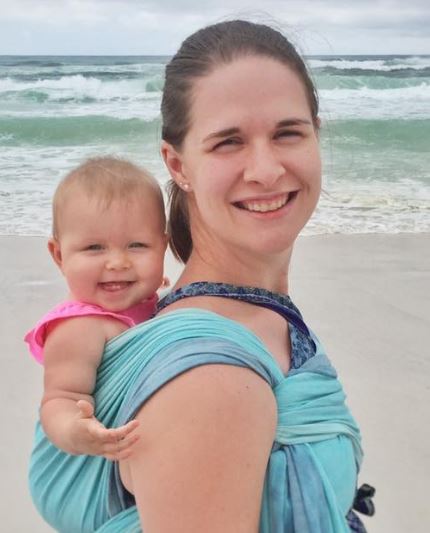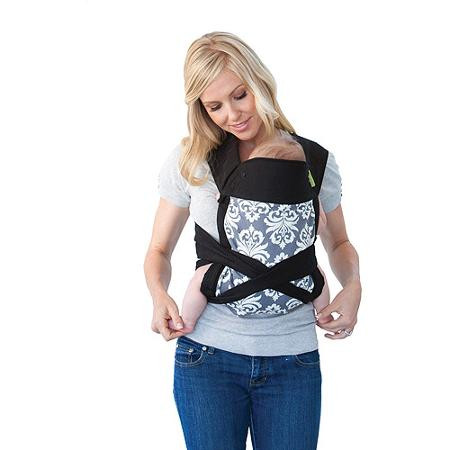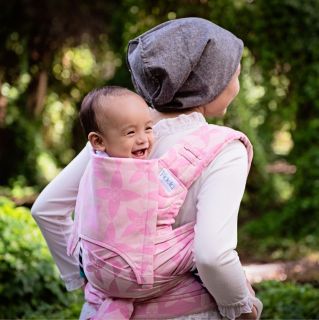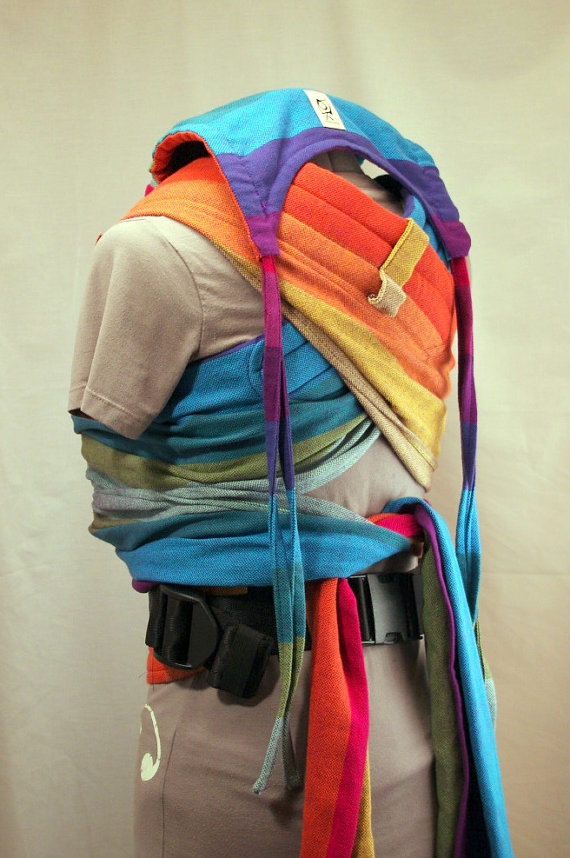Return to Main - DIY Babywearing on Facebook - TICKS Rules for Safe Babywearing - 4 Rules for Safe Fabric Selection
- TICKS Rules for Safe Babywearing - 4 Rules for Safe Fabric Selection
The infant measurement here also matches the Infantino Sash Mei Tai, for comparison. These are good suggestions, but as with any structured carrier, it's a good idea to make a tester out of a cheaper material so you can get a better idea of fit before you cut into any expensive fabric. Plus, if it does fit well, it makes for a great backup carrier to keep in the trunk of your car or in the diaper bag.
These measurements are for a finished body panel, so once you trace out a pattern piece, add 1/2" to all the edges before cutting out your fabric. Then cut out two pieces from your sturdy bottom weight fabric and (optional) a third panel from a third, decorative layer.
Some mei tais include a fancy internal "cinching" system to make the body panel more narrow or shorter for smaller babies. This is optional, as you can achieve the same concept by rolling the waist band over an extra time before tying it around yourself and cinch the panel narrower with a simple ribbon. This video shows how to do this in order to use a standard sized mei tai with a newborn, but it could also be used to fit an older infant in a still-too-big toddler mei tai.
 Alyssa Leonard - 2016-07-16
Return to Main - DIY Babywearing on Facebook
Alyssa Leonard - 2016-07-16
Return to Main - DIY Babywearing on Facebook - TICKS Rules for Safe Babywearing - 4 Rules for Safe Fabric Selection
- TICKS Rules for Safe Babywearing - 4 Rules for Safe Fabric Selection
Mei Tai Tutorial
(skip to tutorials)What is a Mei Tai?
Pronounced "MAY-tie." Also referred to as: MT, brand names Fidella Fly Tai, Infantino Sash, Sew Toot Versatai Traditional Chinese origin.Description
A rectangular body panel with two long shoulder straps coming out of the top corners diagonally and two shorter waist straps coming out of the bottom corners horizontally. The carrier is tied around the waist hanging down, "wrong-side" out like an apron, and then pulled up over baby. The shoulder straps go over the shoulders, under the arms, and either tie under baby's bum or cross over baby, under baby's legs and then tie.Good For
- Front Carries: Good for all ages
- Hip Carries: Good for babies with strong truck control
- Back Carries: All ages (for experienced wearers only)
- Forward Facing: Good for babies with strong head control and decent truck control; usually requires the carrier to be modified/cinched narrower.
Advantages
Incredibly easy to learn to use. Flexible sizing can fit multiple parents. Offers wrap-like support with the ease of a buckle carrier. Ability (with experience and care to monitor breathing) to back carry newborns safely. Waist-strap and two shoulder straps offer good weight distribution for long wearing. Easy to adjust panel size (by rolling the waistband or cinching the bottom) to fit a newborn.Disadvantages
Panel size is dependent on child's size. Therefore a parent who chooses to wear as their baby reaches toddlerhood or preschooler age may need to upgrade to a toddler-size or preschool-size carrier.Variations
- Wrap strap: Straps are wide (10"-15") and flat like a woven wrap.
- Narrow or "Tube" strap: Straps are sewn into a flattened tube (narrower, usually around 4", and double layered.)
- Padded straps: Section of the shoulder straps closest to the body panel include padding, usually either fleece or open cell foam.
- Half-buckle: Waist straps include a buckle closure instead of a tie closure.
- Ring-waist: One waist strap is replaced by double sling rings, which the other waist strap is threaded through like a D-ring belt.
Sizing
Body panel size is based on child's size. Body panel should be tall enough to reach at least up to baby's armpits but not so tall that baby's airway is obstructed. (The waist band can be "rolled" an extra time to shorten a too-tall panel.) The width should be wide enough to support baby's legs from knee-pit to knee-pit, while still allowing the legs to swing freely at the knee. (The body panel can be cinched with a ribbon or hair tie to make it narrower for smaller babies.) The strap length is determined by the wearer's size. Most mei tai strap lengths are considered one-size-fits-most.How to Use
- Basic Mei Tai Front Carry
- How to Use a Mei Tai with a Newborn
- Mei Tai High Back Carry
- Mei Tai Hip Carry
External Tutorials
The following are some links to specific tutorials. These are all great tutorials. However, if you want to draft your own pattern or want more details about your options, scroll past these for information on all your different variation options.- Downloadable PDF: Mei_Tai_Wrap_Strap_Basic.pdf (Printable, no frills, very simple.)
- Very Basic Tutorial from Sleeping Baby Productions
- SewToot Versa-Tai (paid pattern; includes lots of features, Facebook support group and numerous variations)
- Wrap Strap Tablecloth Conversion Mei Tai
- Fine & Fair Tablecloth Conversion Mei Tai Pattern
- Mei Tai with Interchangeable panels
- Barefoot & Pregnant Adjustable Panel Mei Tai
- Hobo Mama Mei Tai with padded straps
- Bea's World Ring Tai (note: a ring tai is technically more like a SSC than a MT and should be considered as such for safety purposes)
Tutorial Sections
Fabric Needed
Tablecloths are popular choices for mei tai conversions for their combination of strength, floppiness, and pretty patterns. Make sure your tablecloth is safe to use and choose an appropriate size. Most tutorials need a minimum of a 60"x84" tablecloth, but you may want a longer tablecloth if you are larger than a US 10-12 or if you prefer longer straps for supportive finishes. If you are working with bolt fabric like duck or twill, it will depend on what your fabric's width is. A good generalization would be about 4 yards of a sturdy, bottomweight fabric, plus a 1/2" yard of whatever fabric you want on the outside of the body panel.Side note - a mei tai needs 2 layers of supportive, bottomweight fabric for the body panel. Many patterns do 3 layers, for a number of reasons. First of all, the third layer can be quilter's cotton or another "unsafe" material that is decorative and gives you the pattern you want. Many licensed character fabrics, for example, are quilter's cotton and generally not strong enough to use on their own, but can be layered over bottomweight fabric and paired with bottomweight straps to give you the look you want. Second of all, a three-layer construction allows you to hide all of your reinforcement stitching on the inside layer, giving your finished carrier a clean, seamless look. If you choose to do 3 layers, you will need less than a square yard (half a yard if you making an infant size and the pattern can be cut out sideways) of your decorative outer layer fabric. The internal layer needs to be particularly strong to hold reinforcement stitches. While osnaburg is a good, wrap-safe bottomweight fabric, it does not do particularly well as a middle layer of a body panel. Duck cloth, canvas, or heavy twill are better options. Just a 1/2 yard is plenty.
Panel Styles & Sizes
A mei tai panel can be incredibly simple - just a plain rectangle. Many people choose to do a rounded edge on top, similar to the Infantino Sash mei tai, for a cleaner look and a little extra neck support. You can also make an "hourglass" shaped body panel that curves in at the middle of the sides; not only does this create more airflow for a cooler carrier, but it also means that if you are using it for a little baby that requires you to roll the waistband an extra time to shorten the panel, you are also automatically narrowing the base for their little legs and may not need to "cinch" the bottom like you normally would for a newborn. The goal for the body panel is to extend from the neck (for a young baby) or armpits (for an older baby or toddler) down to under their bum and back up between the two of you several inches to create a "hammock." The width should fully support baby knee-to-knee but still allow the legs to bend freely at the knee. If the panel is too narrow, as long is your child is of a walking age, this is more of a comfort issue than an actual danger. If it is too wide, you can cinch the bottom (just by scrunching it with your hands while putting baby up if the fabric is particularly floppy, or tied with a ribbon or hair tie with a stiffer/newer carrier.) The easiest way to size your panel is to measure a carrier that you know fits well, but for many DIYers this is not an option. Luckily, the lovely mama who writes the Fine and Fair blog created a Tablecloth Mei Tai Tutorial and suggests these panel measurements:| Size | Width | Height |
|---|---|---|
| Infant | 14-15" | 20" |
| Toddler | 17-18" | 22" |
Shoulder Straps
While there are a couple ways you can make your shoulder straps, there are two basic designs: wide, single-layer "wrap straps," (Like the Fidella Fly Tai, which also includes some padding at the base of the strap) or narrow, flattened tube-like straps (like the Infantino Sash mei tai.) Either of these may or may not include padding at the base of the strap where it attaches to the carrier to cushion the shoulders. Wrap style straps are typically a minimum of 80" long (finished; don't forget to account for shrinkage and the 5" of strap that will be sunk into the body panel) and may be done much longer for plus-size mamas, broad dads, or wearers who prefer the extra length for supportive finishes, such as a tibetan tie-off. 10"-15" is a fairly standard width for wrap straps (finished - add an extra inch or two when cutting them from your fabric.) Wrap straps simply need three sides hemmed with a double folded hem. You can leave the short end that will be inside the carrier unhemmed, or just run a zigzag stitch along that edge if you are concerned about it. Wrap straps will need to be pleated at the end that will be inserted into the body panel. This can be done however you wish, but a good goal is to pleat them down to about 3"-4" wide. A flattened tube strap, like what the Infantino Sash Mei Tai uses, is typically a minimum of 70" long (or longer, as stated above.) Jan from Sleeping Baby Productions suggests cutting them 12"-17" inches wide (giving you a finished width of about 6 1/2") but you can go narrower. The Infantino Mei Tai's straps are only 4" wide, which means you would start with your fabric only 8 1/2" or 9" wide. Instead of hemming the edges, you would fold your fabric lengthwise, right-sides-together, and run a straight stitch along the open edge down the length of the fabric and across one short end. You would then turn the tubes right-side-out, like a pillowcase. You can leave the ends blunt, or taper them at a 45 degree angle. This is simply a matter of appearances and has no functional difference. Either style of straps can be made with padding in the 15" or so closest to the body panel for more cush on the shoulders. This is easiest to do with a tube-style strap because you simply stuff the open end with a few layers of fleece. (Stitch the layers of fleece together before stuffing so they don't bunch up quite as much while trying to get them in.) The Barefoot and Pregnant tutorial is very in depth with a lot of extra features. One of these features that she explains is how to do a hybrid padded-to-wrap style should strap (in parts 9 and 10 of her tutorial.)Waist Straps
Mei tais have a number of waist strap options. For the most part, the options are:- Wrap Straps
- Flattened Tube Straps
- Wrap Strap with Ring Waist
- Buckle Waist
Construction - 2 layer body
The most important part of constructing a mei tai after choosing safe fabric is making sure that your straps are well anchored to your body panel. There are two methods to do this. The first is if you are using two body panel layers. Both of these layers should be strong, woven, bottomweight material. Lay your two body panel pieces together, right sides together, and topstitch around the outside edges, leaving the four strap holes open. Turn the body right-side-out through one of the openings and iron flat (turn the open edges around the strap opening inside the carrier and iron these edges flat, too.) Insert your shoulder straps through the top holes, coming out of the top of the carrier at about a 45 degree angle and sunk into the body about 5". Pin these into place, and then secure them to the body by sewing an x box through all of the layers - simply a rectangle with an X going from corner to corner. These stitches in multiple directions secure the strap from stress from multiple directions. Insert your waist straps similarly at the bottom, running horizontal to the bottom edge. Secure with x boxes as well. Now top stitch around the entire outside edge of the body panel.Construction - 3 layer body
This method hides your reinforcement stitches and also allows you to use a typically unsafe fabric like quilter's cotton for a decorative outside layer. Pin your straps to the inner (hidden) layer of your mei tai. Shoulder strap should be coming out of the top corners and about a 45 degree angle and sunk in about 5". The Waist straps should be coming out of the bottom corners horizontal to the bottom of the body panel, again sunk in 5". Secure all the straps with x boxes. Here's where it gets tricky. Lay your internal layer (that has all the straps reinforced to it) with the straps on the UNDERSIDE, and the right sides of the straps UP. Lay your decorative, pretty layer on top, right side UP. Lay your bottom layer, that will be against baby's back, right side DOWN on top of all this. Pin these three layers together and then top stitch around the top and side edges, leaving the strap holes and bottom open. Then turn the carrier right side out (reaching between the decorative layer and the layer that will be against baby) and make sure you pull the straps through the holes. Iron the carrier flat, turning the strap hole edges and bottom edge in. Top stitch around the entire carrier.Learn to use it!
Make sure you are always using the TICKS rules for Safe Babywearing! Here are a few YouTube videos to get you started.- Basic Mei Tai Front Carry
- How to Use a Mei Tai with a Newborn
- Mei Tai High Back Carry
- Mei Tai Hip Carry
| I |
Attachment | History | Action | Size | Date | Who | Comment |
|---|---|---|---|---|---|---|---|
| |
Mei_Tai_Wrap_Strap_Basic.pdf | r2 r1 | manage | 285.3 K | 2016-11-25 - 18:04 | AlyssaLeonard |
Topic revision: r10 - 2016-12-07 - AlyssaLeonard
Ideas, requests, problems regarding TWiki? Send feedback






